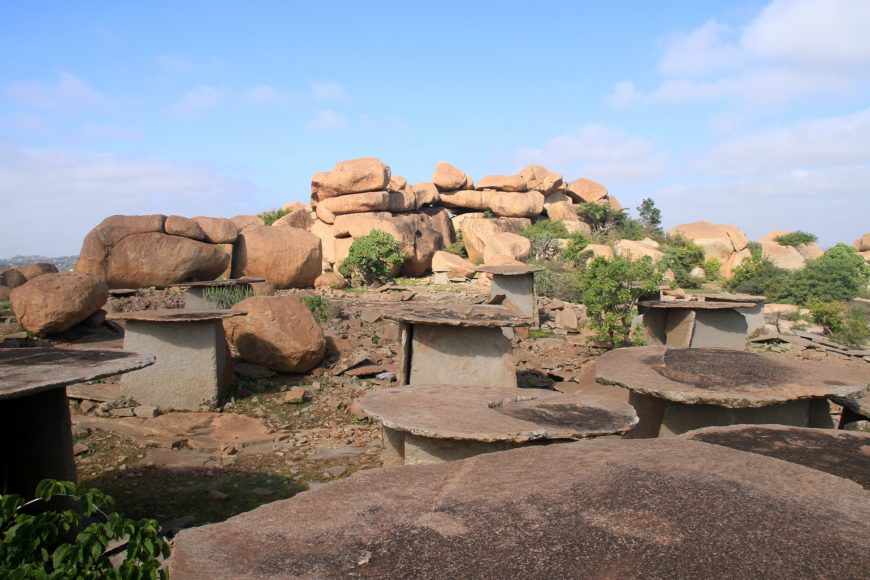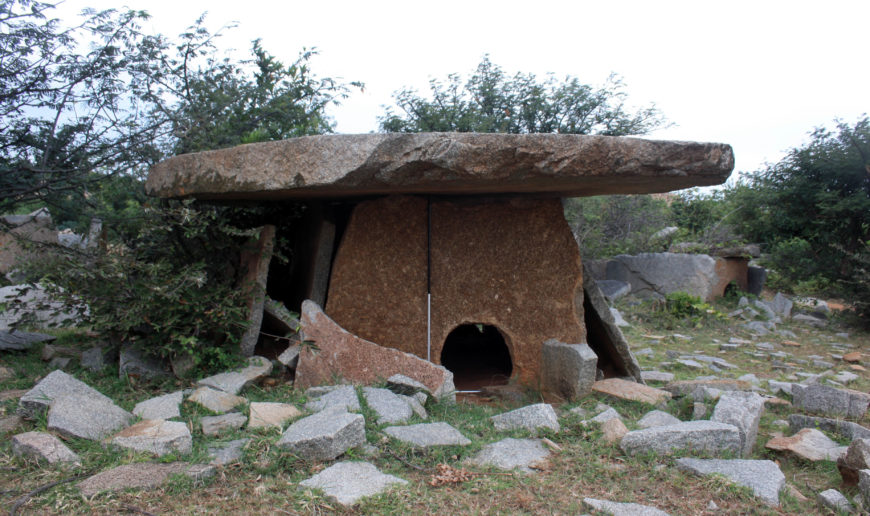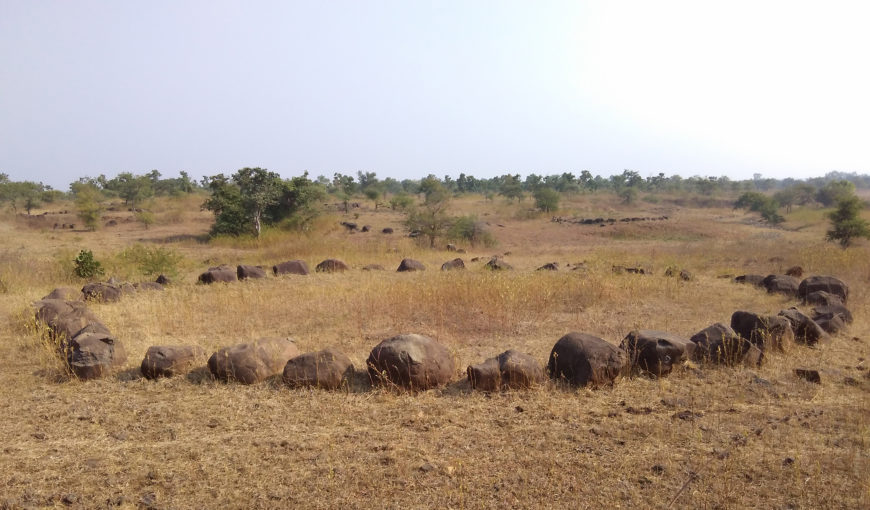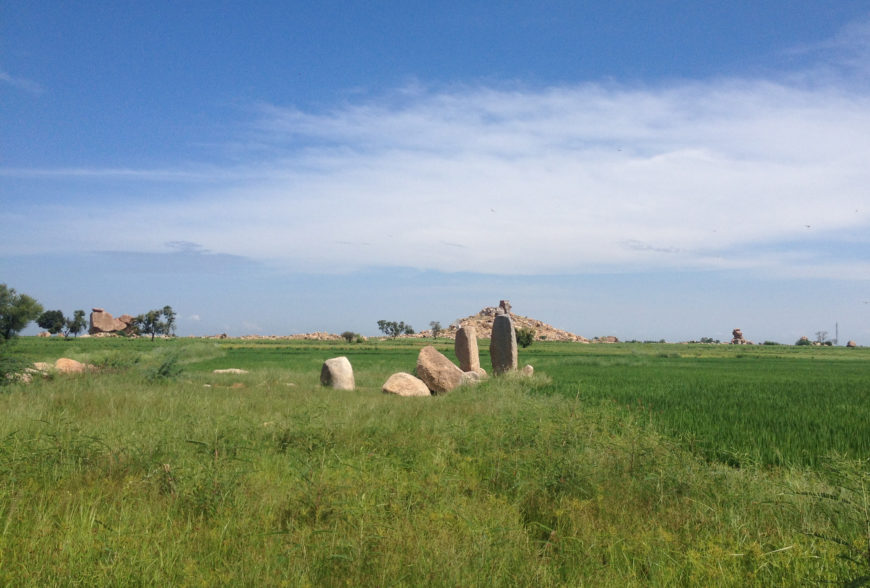
Dolmen megaliths at Hire Benakal, Karnataka, India, c. 800–200 B.C.E. (photo: Ravibhalli, CC BY-SA 3.0)
Megaliths are large-scale stone structures associated with mortuary, ritualistic, and commemorative functions. They were produced across the Deccan Plateau during the Iron Age (late second–early first millennium B.C.E.). A range of monuments are seen as megaliths, with the common distinctive feature being their construction out of roughly dressed slabs of stone. Megaliths were produced by cultures across Europe, Asia, and Central and South Africa. In India, megaliths are found not only across the Deccan and southern India but also in the Vindhya and Aravalli mountain ranges (in central India), as well as in Assam and the Chotanagpur plateau (in northeast India).

Dolmenoid cist from the Western Group at Hire Benakal, North Karnataka (photo: © Srikumar Menon used by permission)
There are typically three types of megaliths found in the Deccan: chamber tombs, unchambered tombs, and megaliths not associated with burials.
Chamber tombs consist of a chamber built out of two or four vertical slabs with a horizontal capstone placed on top. Underground chambers are known as cists, while aboveground chambers are known as dolmens. In cases when chambers are only partially underground, they are called dolmenoid cists.

Stone circles at Junapani, Nagpur district, Maharashtra, 1000 B.C.E.–300 C.E. (photo: Kailash Mohankar, CC BY-SA 4.0)
There are three types of unchambered burials: pit burials where funerary items are buried in pits, urn burials where they are placed in a large pot or urn, and sarcophagus burials where a terracotta trough contains the items. Pit burials are sometimes marked by a circle of large stones, a cairn (heap of stones), or both. They are also often accompanied by slabs of standing stones (called menhirs).

Axe head, Iron Age (c. 1200–600 B.C.E.), iron, 23.8 x 9.5 cm, Nagpur, Maharashtra, India (© Trustees of the British Museum)
The earliest commemorative and burial practices in the region appear to have begun in the neolithic-chalcolithic period (7000 B.C.E. to 3000 B.C.E.) with pit and urn burials, as seen in older sites (such as at Watgal, Karnataka and Inamgaon, Maharashtra). Chamber tombs with megaliths were particularly an Iron Age development. This is confirmed by the presence of iron artifacts such as arrowheads, axe heads, knife blades, sickle, clamp, lance, blades, tridents, and spearheads in burials (at Nagda, Naikund, Borgaon, and Junapani in Madhya Pradesh). Scholars have suggested that these indicate significant metallurgical developments in iron extraction, smelting, and production of tools.
Megalith sites are generally accompanied by other material markers such as black and red ware ceramics. Agate (stone) beads, carved steatite earrings, human and animal figures, copper and bronze artifacts, terracotta figurines, tortoise shells, lapis lazuli beads, and the remains of horsegram (a legume native to tropical southern Asia) and ragi grains are also sometimes found.
The megaliths of the Deccan were among the earliest archaeological remains to garner interest from from British colonial archaeologists, as well as officers who had an interest in archaeology, both amateurs and professionals. The earliest investigations were unsystematic and consisted of opening up many megalithic stone chambers, the contents of which were noted and itemized. The British archaeologist Mortimer Wheeler initiated a more systematic investigation in the mid-1940s, arguing that the megaliths were the remains of a homogenous group of people. However, more recent studies have substantially dismissed this view.
Scholars now concur that the megaliths are best understood as material remnants signifying the social stratification and internal variations of agro-pastoral communities across the Deccan. They are either related to or are the results of commemorative-memorial practices, craft production, and consumption. The erection of megalithic structures was an exercise in communal commemoration as well as applying technical knowledge. Burial practices associated with them appear to have diffused across the regions of northern Karnataka, and western Andhra Pradesh.
There is variation both within and between megalithic sites, suggesting that regional ecology and socio-political organization played a role in their production. Social meanings may be inferred through variations in the number of people buried, how the bodies were treated, and the number and kind of grave goods deposited with them. These reflect social hierarchy, with differences possibly being based on occupation, lineage, martial prowess, and cultic value.

Stone alignment at Sanganakallu, Bellary, North Karnataka (photo: © Srikumar Menon used by permission)
While most megaliths are associated with mortuary contexts and are typically found in close proximity to settlements from the period, others are more secluded, and some bear traces of abandonment. Some sites (such as in north-eastern Karnataka and western Telangana) were not associated with burial practices: standing stones appear to have been erected to track astronomical events such as solstices and equinoxes, possibly in connection with seasonal crop cycles. These also reflect a heightened degree of social organization, requiring large-scale communal rituals as well as managerial and specialist skills to procure and organize labor and resources. Remains of water pools, sedimented terraces, and herding camps have been found accompanying these sites, supporting their connection with agricultural resources.
As of writing, scholarly interest in Deccan megaliths is growing, though many sites are also under threat due to encroachment and urbanization.
Additional resources
Peter G. Johansen, “The South Deccan Iron Age: Antecedents to Early Historic Andhradeśa” Amravati: The Art of an Early Buddhist Monument in Context edited by Akira Shimada and Michael Willis (London: British Museum, 2016).
Srikumar M. Menon, “Megaliths and Later Monuments,” Ancient India: Identities, Boundaries and Cultural Practices, edited by H. Kadambi and D. A. Prasanna (2019).
Aloka Parasher, “Nature of society and civilisation in early Deccan” The Indian Economic & Social History Review, volume 29, number 4 (1992), pp. 437–77.
Upinder Singh, A History of Ancient and Early Medieval India: From the Stone Age to the 12th Century (Noida, Uttar Pradesh: Pearson India, 2016).
Drawing from articles on The MAP Academy



